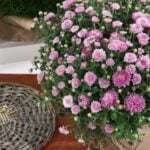Are you looking for creative beach gardening ideas to transform your coastal property into a stunning oasis? Beach gardening offers a unique set of challenges and opportunities, but with the right knowledge and tips, you can create a beautiful and thriving garden by the sea.
From choosing the right plants to incorporating natural beach elements, designing, maintaining, and dealing with unique challenges, this article will guide you through every step of creating a stunning beach garden that flourishes in the coastal environment.
When it comes to beach gardening ideas, selecting the right plants is crucial for a successful garden. In this article, we will explore low-maintenance and drought-resistant plant options, species that can tolerate salt spray and sandy soil, as well as how to incorporate native beach plants into your garden for a truly authentic coastal look.
Whether you’re new to beach gardening or looking to revamp your existing garden, these plant selection tips will be invaluable in helping you achieve a lush and vibrant beach landscape.
In addition to plant selection, designing your beach garden plays a key role in its overall beauty and functionality. We’ll provide expert tips for creating a coastal-inspired garden design that complements its surroundings while incorporating natural beach elements such as driftwood, shells, and rocks. Furthermore, we will discuss creating pathways and seating areas for leisurely enjoyment so that you can make the most out of your stunning beach garden.
Choosing the Right Plants for Beach Gardening
When it comes to beach gardening, selecting the right plants is crucial for a successful and thriving coastal garden. It’s important to choose low-maintenance and drought-resistant plant options that can tolerate the unique conditions of the beach environment. Look for plants that can withstand salt spray, sandy soil, and harsh winds commonly found near the coast.
One popular option for beach gardening is incorporating native beach plants into your garden. Native plants are well-adapted to the local climate and soil conditions, making them an ideal choice for beach gardens. Some common native beach plants include sea oats, pink muhly grass, and seaside goldenrod. These plants not only add a natural aesthetic to your garden but also help support local ecosystems.
In addition to native beach plants, consider ornamental grasses, succulents, and coastal wildflowers when choosing plants for your beach garden. These options are well-suited for sandy soil and can thrive in the salt-laden air near the coast. By carefully selecting the right plants, you can create a beautiful and resilient beach garden that enhances the natural beauty of your seaside home.
| Plant Type | Examples |
|---|---|
| Native Beach Plants | Sea oats, pink muhly grass, seaside goldenrod |
| Ornamental Grasses | Pampas grass, fountain grass |
| Succulents | Aloe vera, agave, sedum |
| Coastal Wildflowers | Beach sunflower, blanket flower, sea lavender |
By carefully considering these options when choosing your beach gardening ideas,you will be able to create a stunning coastal garden that thrives in its unique environment.
Designing Your Beach Garden
When it comes to designing a beach garden, there are several key elements to consider in order to create a beautiful and functional space that thrives in a coastal environment. Here are some tips for creating a coastal-inspired garden design:
- Incorporate natural beach elements such as driftwood, shells, and rocks: One of the best ways to achieve a beachy feel in your garden is by incorporating natural elements that you might find at the shore. Use driftwood as edging for your garden beds, scatter seashells among your plants, and use rocks to create focal points or pathways within the garden.
- Create pathways and seating areas for enjoyment: A well-designed beach garden should not only be visually appealing but also functional for relaxation and entertainment. Consider creating pathways using gravel or stepping stones that wind through the garden, leading to cozy seating areas where you can enjoy the ocean breeze.
In addition to these design tips, it’s essential to choose the right plants for your beach garden. Look for low-maintenance and drought-resistant plant options that can tolerate salt spray and sandy soil. Consider incorporating native beach plants into your garden design as they are well adapted to the coastal environment.
By following these design principles and selecting suitable plant species, you can create a beautiful and thriving beach garden that enhances the natural beauty of your seaside home. Whether you have a small space or a sprawling yard, there are plenty of creative beach gardening ideas to bring the essence of the coast into your outdoor oasis.
Maintaining Your Beach Garden
When it comes to beach gardening, maintenance is key to ensuring the longevity and success of your coastal garden. Watering and fertilizing in a coastal environment can pose unique challenges due to the sandy soil and salt spray. It is essential to choose low-maintenance and drought-resistant plant options that can thrive in such conditions. Incorporating native beach plants into your garden can also help in reducing the need for excessive maintenance.
In addition to proper plant selection, protecting your garden from high winds and salt spray is crucial for maintenance. Creating windbreaks using natural elements such as rocks or planting hedges can go a long way in safeguarding your plants. Proper soil management and erosion control are also important aspects of maintaining a beach garden. Implementing strategies such as mulching and using erosion-control blankets can help prevent soil erosion in coastal environments.
One aspect of maintaining a beach garden that is often overlooked is pest and disease management. Coastal environments can be more prone to certain pests and diseases, so it’s important to stay vigilant and take preventive measures. Using environmentally-friendly pest control options is highly recommended for beach gardening to minimize the impact on the delicate coastal ecosystem.
| Maintenance Tips | Benefits |
|---|---|
| Choose low-maintenance, drought-resistant plants | Reduced need for frequent watering and care |
| Create windbreaks and use erosion-control blankets | Protects plants from high winds and prevents soil erosion |
| Use eco-friendly pest control options | Minimize impact on the coastal ecosystem while managing pests |
By implementing these maintenance tips, you can ensure that your beach garden remains healthy and thriving for years to come.
Dealing With Unique Challenges in Beach Gardening
When it comes to beach gardening, there are several unique challenges that gardeners must overcome in order to create a thriving coastal garden. From managing sandy soil and drainage issues to protecting the garden from wildlife and beach debris, beach gardening requires specific strategies for success.
Strategies for Managing Sandy Soil and Drainage Issues
Sandy soil is a common challenge for beach gardeners, as it drains quickly and lacks essential nutrients. To combat this issue, consider incorporating organic matter such as compost or mulch into the soil to improve its structure and fertility. Additionally, choosing plants that are well-adapted to sandy conditions, such as succulents and ornamental grasses, can help ensure the success of your beach garden.
In terms of drainage issues, raised beds or mounded planting areas can be effective solutions for improving drainage in beach gardens. By elevating the planting area, excess water is able to drain away more easily, preventing waterlogged soil and potential damage to plant roots.
Pest and Disease Management in Coastal Environments
Coastal environments can often be more prone to certain pests and diseases due to the unique climate and proximity to the ocean. It is important for beach gardeners to be proactive in addressing these issues by regularly monitoring their plants for any signs of pest infestations or disease outbreaks.
Using natural pest control methods and selecting disease-resistant plant varieties can also help mitigate these challenges in beach gardens. Additionally, proper spacing between plants and good air circulation can minimize the risk of disease spread within the garden.
Protecting Your Garden From Wildlife and Beach Debris
Beach gardens are often exposed to wildlife such as birds, rabbits, and deer that may feed on plants or cause damage to the garden. Installing barriers such as fences or netting can help deter wildlife from entering the garden. Additionally, using plant choices that are less appealing to wildlife can also reduce the risk of damage.
In addition to wildlife, beach gardens are susceptible to debris washing ashore from the ocean. Regularly cleaning up the garden area and properly disposing of any debris is important for maintaining a clean and visually appealing coastal garden. Incorporating sturdy landscaping elements such as rocks or driftwood can also add natural charm while serving as a barrier against incoming debris.
Beach Gardening for Small Spaces
Creating a beautiful and thriving beach garden doesn’t have to be limited by space constraints. In fact, with some creativity and strategic planning, small beach gardens can be just as captivating as larger ones. Whether you live in a coastal cottage or a high-rise condo overlooking the shore, there are plenty of beach gardening ideas to maximize your space and create a stunning seaside oasis.
Creative Container Gardening Ideas for Beach Homes
For those with limited outdoor space, container gardening is an excellent way to bring the beach garden aesthetic to your home. Consider using a variety of containers such as pots, hanging planters, and window boxes to showcase a diverse array of coastal plants.
Succulents, ornamental grasses, and drought-resistant flowers like lavender and sea thrift are perfect choices for container gardening in a beach environment. Additionally, incorporating driftwood or seashells into your containers can add an extra touch of coastal charm to your small beach garden.
Vertical Gardening Options for Limited Space
Maximize your vertical space by implementing vertical gardening techniques in your small beach garden. Installing trellises or wall-mounted planters can create opportunities for growing climbing vines, cascading flowers, or even edible plants like strawberries or cherry tomatoes. Utilizing hanging baskets or tiered shelving can also help make the most of limited space while still allowing for an abundance of greenery in your beach garden.
Tips for Maximizing Space in a Small Beach Garden
When working with a small outdoor area, every inch counts. Consider multi-functional furniture that can also serve as storage or planting surfaces. Use raised beds or stacked planters to create depth and visual interest in your small beach garden. Incorporate reflective materials such as glass or mirrors strategically to give the illusion of more space. With thoughtful planning and creative design, small beach gardens can be just as enchanting as their larger counterparts.
Embracing these beach gardening ideas for small spaces will allow you to transform even the tiniest outdoor areas into charming coastal retreats. By maximizing all available space through innovative container gardening techniques, vertical gardening options, and smart space utilization strategies, you can create an inviting and sustainable beach garden no matter how limited your outdoor area may be.
Creating a Sustainable Beach Garden
Incorporating environmentally-friendly practices in your beach garden is not only beneficial for the planet, but it can also create a more sustainable and resilient garden. Here are some ideas to help you create a sustainable beach garden:
- Using recycled and natural materials in your garden design: Incorporating recycled materials such as driftwood, reclaimed wood, or repurposed containers can add a unique and environmentally-friendly touch to your beach garden. Additionally, using natural materials like mulch or compost can help improve soil quality and reduce the need for chemical fertilizers.
- Choosing eco-friendly fertilizers and pest control options: Opt for organic and eco-friendly fertilizers to minimize harmful runoff into the surrounding beach ecosystem. Natural pest control methods such as companion planting or introducing beneficial insects can help manage pests without the use of harmful chemicals.
When creating a sustainable beach garden, it’s essential to consider the impact of your gardening practices on the surrounding environment. By making conscious choices in your garden design and maintenance, you can contribute to the preservation of the beautiful coastal ecosystem.
Lastly, another way to create a sustainable beach garden is to minimize water usage by incorporating drought-resistant plants and implementing efficient irrigation systems. Collecting rainwater for irrigation purposes and utilizing water-saving techniques such as mulching can also help conserve water in your beach garden.
Creating a sustainable beach garden allows you to enjoy a beautiful outdoor space while minimizing your ecological footprint and preserving the natural beauty of the coastal environment.
- Incorporating environmentally-friendly practices in your beach garden
- Using recycled and natural materials in your garden design
- Choosing eco-friendly fertilizers and pest control options
Showcasing Successful Beach Gardens
In conclusion, beach gardening offers a unique and rewarding opportunity to create a beautiful and sustainable garden in a coastal environment. By choosing the right plants that can thrive in sandy soil and salty air, incorporating natural beach elements, and implementing sustainable practices, you can create a thriving beach garden that brings joy and tranquility to your outdoor space.
When it comes to choosing plants for your beach garden, opt for low-maintenance and drought-resistant options that can tolerate salt spray and sandy soil. Additionally, incorporating native beach plants into your garden can not only add to the coastal aesthetic but also thrive in the unique environment. Consider using creative container gardening ideas or vertical gardening options for limited space in small beach homes.
Proper maintenance of your beach garden is essential for its long-term success. This includes best practices for watering and fertilizing in a coastal environment, protecting your garden from high winds and salt spray, as well as proper soil management and erosion control. By implementing these strategies and dealing with unique challenges such as pest management and drainage issues, you can ensure the health and vitality of your beach garden for years to come.
Overall, showcasing successful beach gardens around the world provides inspiration for aspiring beach gardeners as they embark on their own coastal gardening journey. With dedication, creativity, and a commitment to sustainability, anyone can achieve their own thriving beach garden paradise.

Welcome to my gardening blog! I am passionate about plants and enjoy sharing my knowledge and experiences with others. In this blog, I will write about everything related to gardening, from tips on how to get started to updates on my own garden projects.





